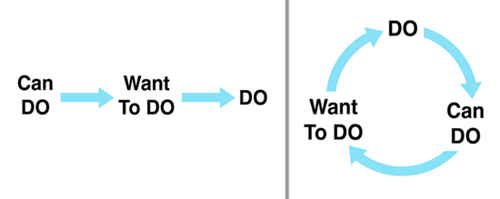by Robert Sun
Learning is often viewed as a linear process. First, the thinking goes, students must be convinced they can complete a task. For kids who question their ability to learn, this is a big stumbling block. It puts the onus on teachers to find ways to overcome doubt, negative self-image and prior failures.

Next, teachers are expected to discover a way for children to become self-motivated. They must show their students a connection to prior learning, or find an intrinsic appeal in the subject matter. Only after these two steps have been accomplished are students considered ready to move on to the final step: learning something new.
The drawback with this approach is its narrow perspective. It places too many steps in sequence, with too many preconditions. Loaded with roadblocks, it makes effective learning difficult. A better model is to think of instruction not as a straight line but as a circle, with entry possible at any spot along the circumference.
Such a model is not only more flexible, but also more inviting to children of varying interests and abilities. Now “do” can be an entry point—as well as “want to do.”

A circular model also increases the ways in which a child can be motivated. The video game industry has used this paradigm to great effect, changing the culture of an entire generation.
Video games succeed because of their non-threatening, open, and self-reinforcing approach to acquiring new skills. First In Math’s digital content is designed to exploit the circular nature of learning using the same key attributes of popular video games: comprehensive content; multiple points of entry; high engagement; a seamless gradient of challenges; a sense of control; short cycle of play and the freedom to make mistakes.
When correctly applied, the circular pattern provided by digital learning games on the First In Math site can actually become a spiral, leading to ever-higher levels of math achievement. As all teachers know, negative attitudes can be self-reinforcing in children. The short cycle of play in a digital game, however, can solve the problem. One quick success presents the child with a question: “Do I go away, or do I continue?” Most will choose the Start button and continue.
When children admit to themselves, “I can do this,” it introduces a new feeling based on the natural response to previous success. Instead of worrying about the threat of a bad grade or a negative reaction from their teacher or parent, kids now think, “I did better than I thought I could, and perhaps I’ll do as well next time.” After working three decades with children and mathematics, my experience confirms that it is not motivation that creates action, but taking action that creates the motivation to do more.
Before long, success eliminates fear. A new perspective takes hold, and the spiral of progressive achievement becomes a reality.
There is no magic formula for maths success, but a top-quality tool like First In Math can provide an environment for the most overlooked aspect of maths instruction: practice. Like playing soccer or learning the piano, math is a skill that requires practice. When all the right attributes are in place, a digital game for math practice can be immensely effective. It’s up to us to provide that welcoming environment—and then let kids do what they do best: explore and learn for themselves.
ROBERT SUN is the CEO of Suntex International and inventor of First In Math, an online program designed for energizing every child to learn, love and live mathematics.